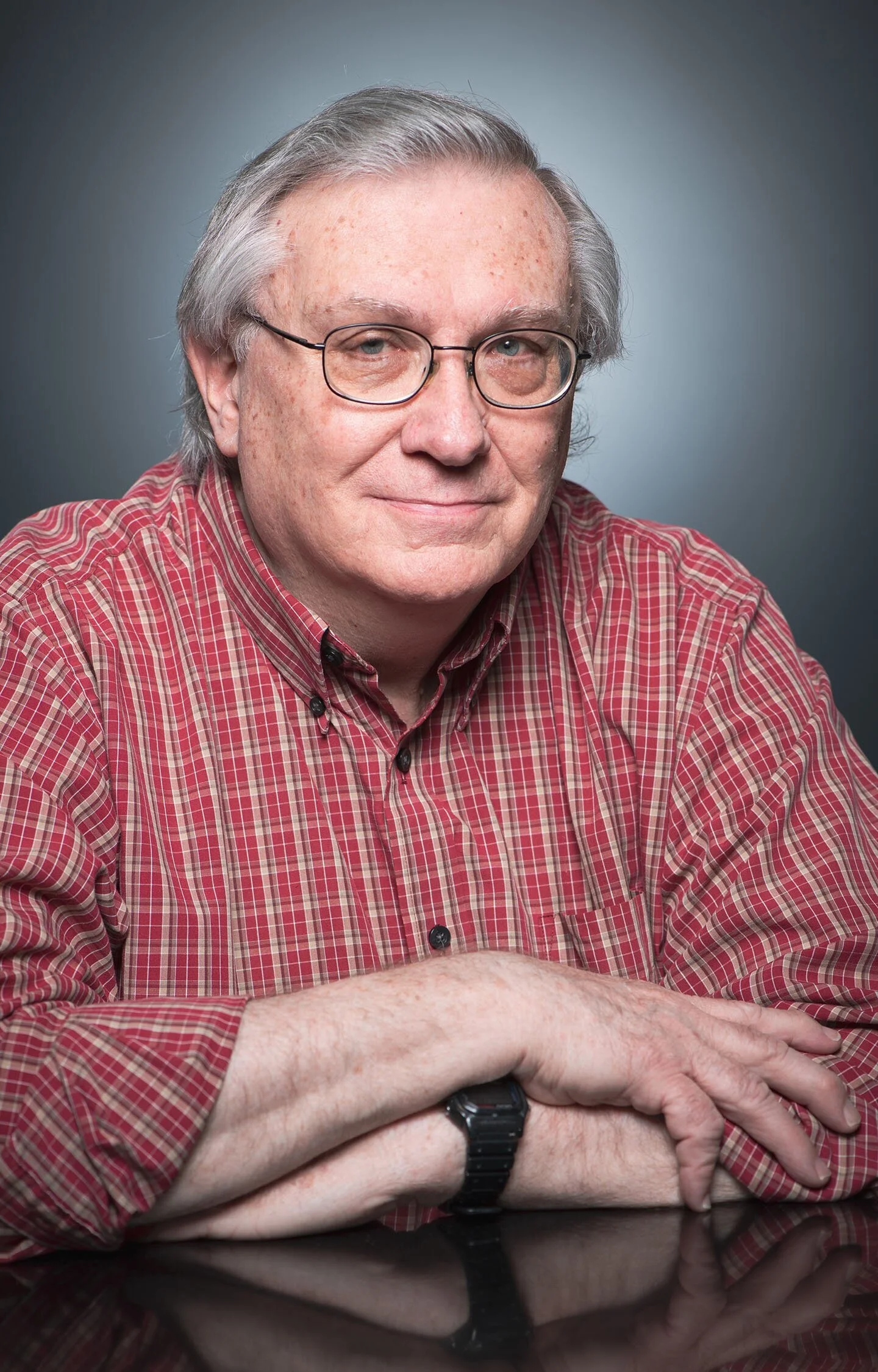Interview with artist Kevin Kresse
Kevin Kresse is a native of Little Rock and full-time sculptor and painter. He has earned national and international acclaim for his work. In 2015 he received the Arkansas Governor’s Individual Artist of the Year Award and in 2016 he was recognized by the National Endowment for the Arts. In the last 20 years, Kevin has placed more than 20 public sculptures throughout Arkansas and as far away as Alaska. And now, he was just chosen to sculpt Johnny Cash for the US Capitol Statuary Hall in Washington, DC. Read more about that here. To see more of Kevin’s work, visit his website kevinkresse.com.
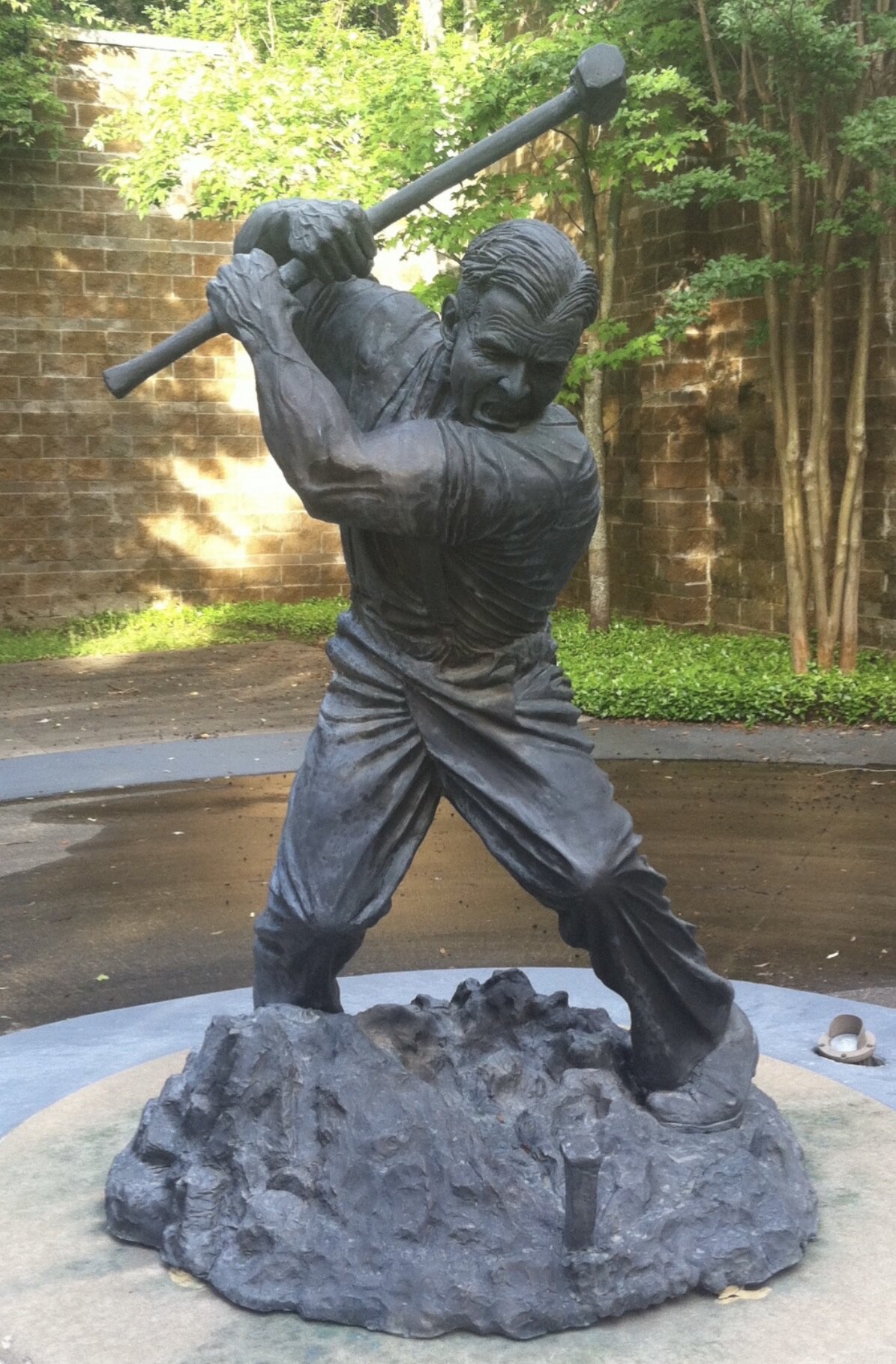
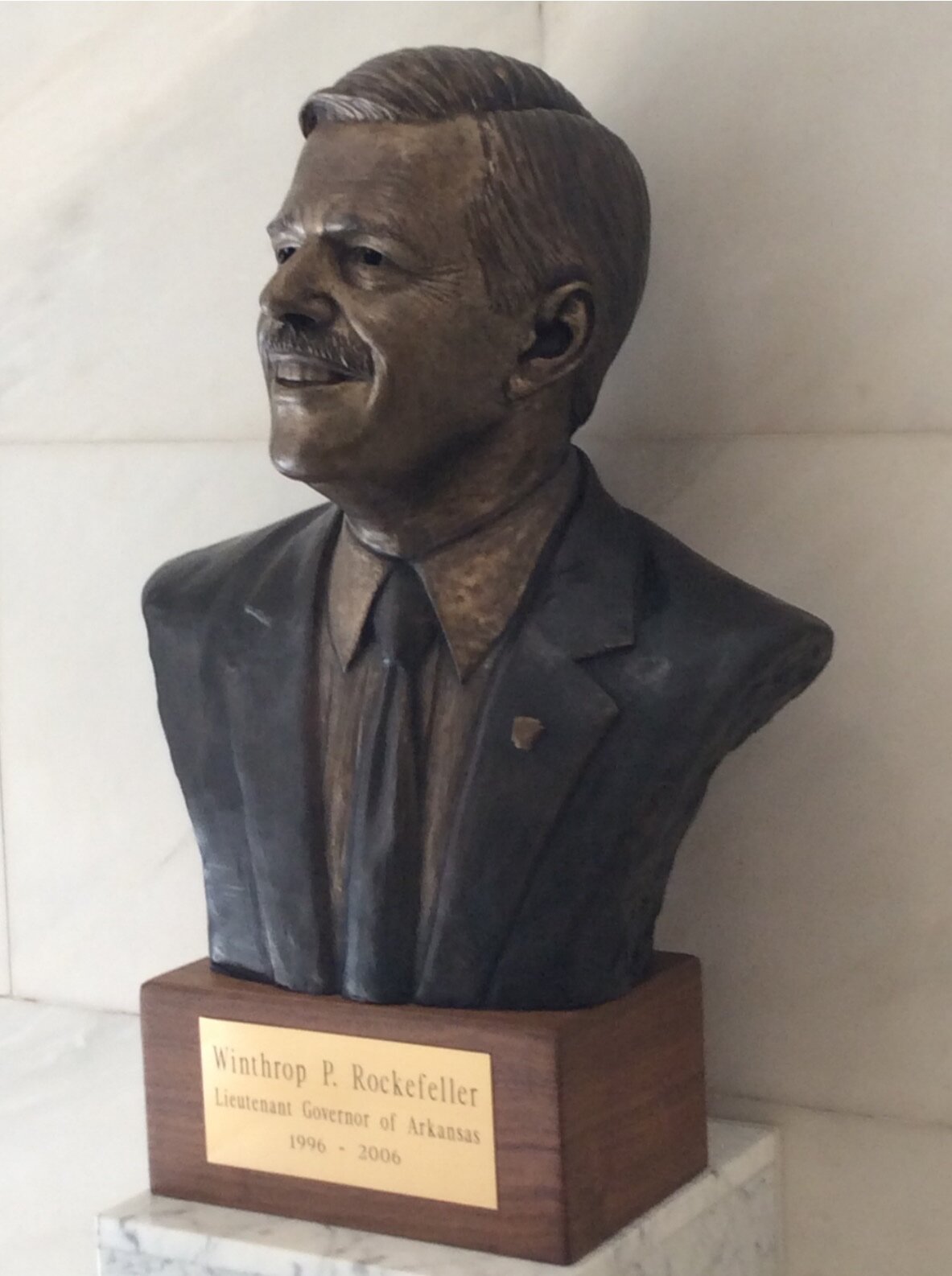
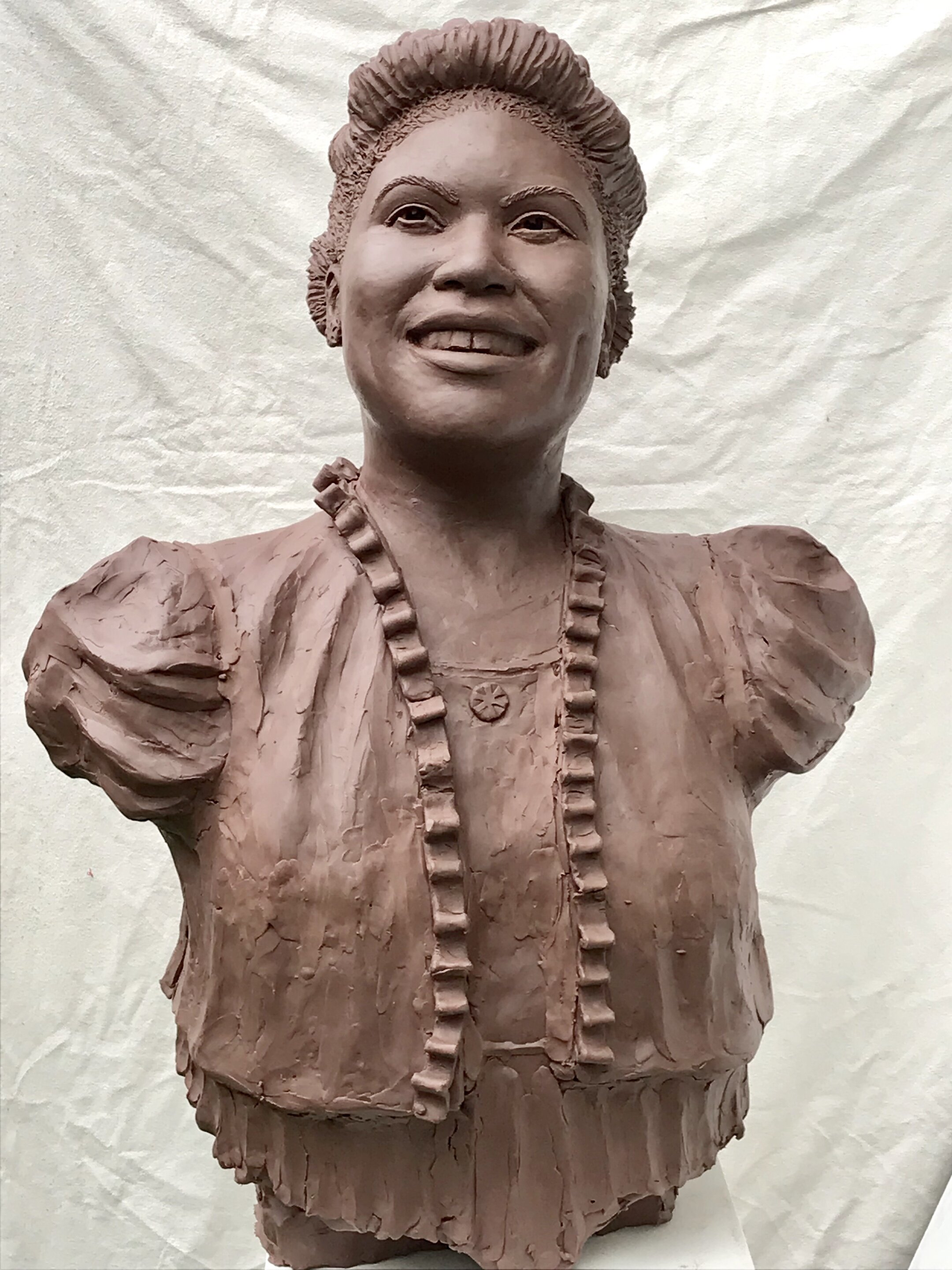
AAS: Kevin, first of all, congratulations on the recent news of being chosen to sculpt the statue of Johnny Cash for the National Statuary Hall at the US Capitol… I can only imagine how you feel.
Johnny Cash Statue prototype, clay
KK: Thank you! Yeah, it’s been a couple of weeks now and it’s still sinking in bit by bit. This project was announced over two years ago, so I was quietly working on it during that time. Even when I was announced as one of the three finalists, I didn’t post anything on social media. I just wanted to quietly focus on the work.
I felt a real responsibility as the only Arkansas artist in the finals. We have SO many world class artists here in Arkansas, in all different disciplines of the arts. As far as my career, this was the biggest stage so far. I really wanted to get Johnny right technically, but also get Johnny’s qualities of humbleness and soulfulness into the piece as well.
Since I’ve won the commission, things have really blown up and it’s all been quite surreal. Sculpting Johnny Cash for the US Capitol is such an incredible honor, and I have a huge desire to knock it out of the park for Arkansas.
Johnny Cash, life + 1/8, clay
AAS: Talk about growing up in Little Rock and how your passion for art developed. I know it’s somewhat of a family thing; I learned that when I interviewed your sister Cynthia back in November.
KK: Cynthia did a great job of painting a picture of our family upbringing, but I’ll throw in my bits. I am number 10 out of the 11 kids. My dad was the electrician, car mechanic, plumber, carpenter, etc. My mother sewed clothes for the kids, did all the cooking, designed personal cakes for us, etc. I grew up seeing all types of things being made by hand. If you wanted something, the first inclination was to try to make it. I’ve never really thought about it before, but I think that mindset has served me well as an artist. I haven’t been intimidated to try new mediums… I know that if I keep trying, I’ll eventually get better at whatever it is.
AAS: Where did you learn to sculpt and paint?
KK: Well, I never had an art class until I got to college. Life drawing was probably the most important for the future me. I had a few painting classes, each with a different teacher, but it was an uneven experience. I had one sculpture class my very last semester, which I loved. I actually learned a lot about color and composition in my design and graphics classes. I went into advertising for a few years after college, until I decided that was not going to be my life‘s work. I really started painting when I was 27, figuring out who I was in the studio. I don’t think I arrived at an answer until several years later. Sculpture came back in my life when I started teaching drawing/ painting at the Arkansas Arts Center (now Arkansas Museum of Fine Arts). I sat in on figure sculpting classes, doing clay work. Frustrated with the fired clay chipping or breaking, I went back to UALR and learned bronze casting with Michael Warrick. But honestly, both painting and sculpting, I learned in the studio through trial and error.
AAS: You have said you have a passion for Arkansas musicians and your busts of Levon Helm and Al Green are so wonderful. Would you talk about those?
Levon Helm, life + 1/8, bronze, Marvell, Arkansas
Al Green, life + 1/8, clay,
KK: Levon Helm was a commission I received about four or five years ago. It’s funny, because after the first meeting I did some drawings of a serious bust. Levon seemed too upbeat for that pose, so after the second meeting I worked on more of a smiling Levon. At the third meeting, Levon‘s old friend Paul Berry came for the first time. He said that Levon needed to be singing. I told him I had never seen a singing bust and was worried it would simply look like he was in pain. Once I put the microphone in, there was some context for the facial expression, and I think it worked to create a very unique bust.
Al Green was a challenge, because he has such an incredibly expressive face, especially when he’s singing. I took him through several different incarnations, until I landed on one that I thought touched on some of my favorite looks. It’s definitely a composite, but it feels like him to me.
AAS: What is your process for creating a bronze sculpture? Where are they cast?
KK: If I know something is going to be cast in bronze, then I sculpt it using an oil-based clay. I don’t have to worry about it drying out, the only concern is keeping it out of extreme heat; it can actually melt all the way down to liquid. For the mold making and casting, I take my pieces to the Crucible foundry in Norman, OK. I’ve been using them for close to 20 years and have a great relationship with everyone there.
AAS: You have also created some very large sculptures for outdoor installations like General William Orlando Darby in Cisterna Park in Fort Smith and The Family and Breaking The Cycle in Little Rock. Were you given guidance on the subject for those sculptures?
General William O Darby, life + 1/4, bronze, Cisterna Park, Ft. Smith, Arkansas
KK: Well, those three pieces are actually good examples of the different types of commissions. In Breaking the Cycle, the only guidance was “We’d like something with a child in it.” I didn’t want to do anything “cutesy” with a kid. That piece is about breaking generational cycles of fill in the blank… whether that be addiction, going into the family business, belief systems, parental abuse, etc. The child has a hand on his father’s shoulder, whom he still loves, but he’s not pushing the problem forward any longer. The parent has had an epiphany as well, ready to start over.
In The Family, I was only given direction on specifically what the family members were to be doing. I didn’t want to do a Wonder bread white family, so I used a black friend as a model for the dad, my friend from Ecuador as the mother, and a Latina child on the bike.
For the General Darby sculpture, they definitely wanted him on a 1942 Harley, pointing out a direction to his troops. This was a piece where attention to detail was crucial. I am not a military person, but I did know not to get the details on the uniform and the bike wrong! I called in my friend Patrick Fleming, who is a painter and sculptor in Little Rock, to come in and help. He’s a motorcycle guy, as well as a military vet. Patrick was a real asset in pointing out areas I was ignorant about and helping get the details right. Also, in my research I discovered he played clarinet in his father’s dance band, during his high school years. The fingers on his right hand, which is pointing, are all lined up straight like soldiers. His left hand, which is on the brake, is in the position of playing a clarinet. It’s a subtle thing that no one would really notice, but I like knowing it’s in there.
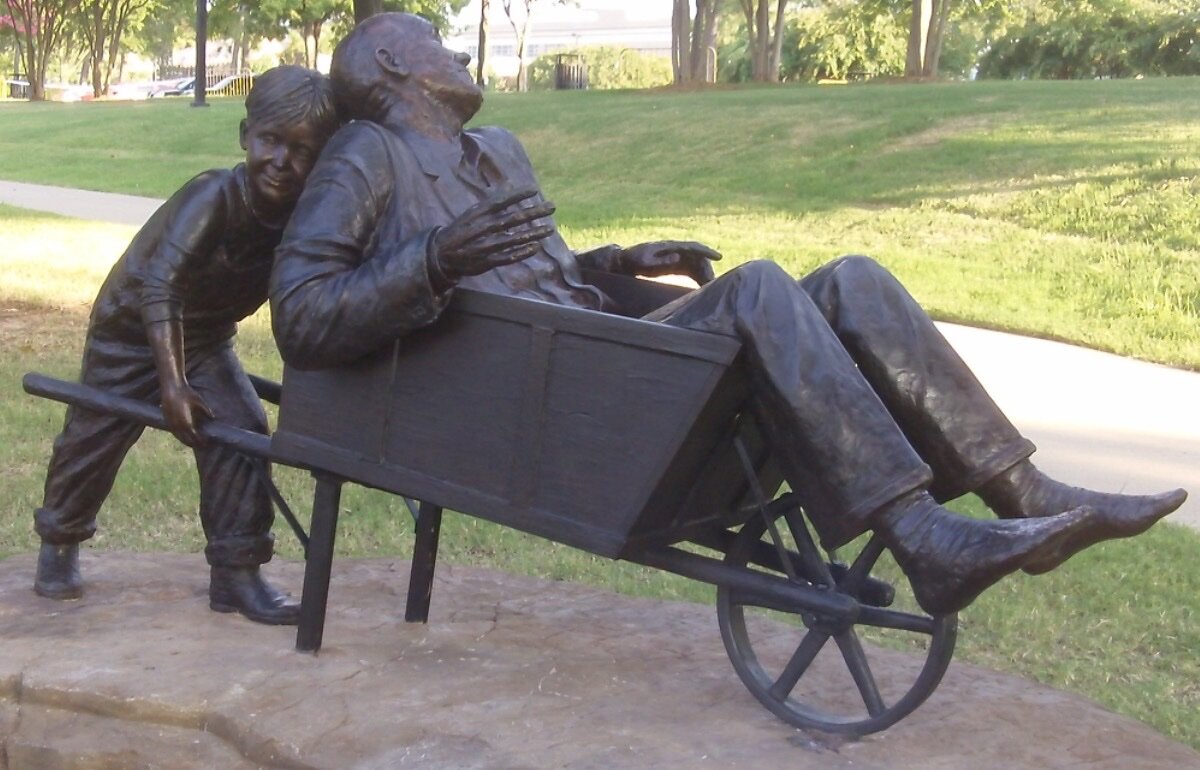
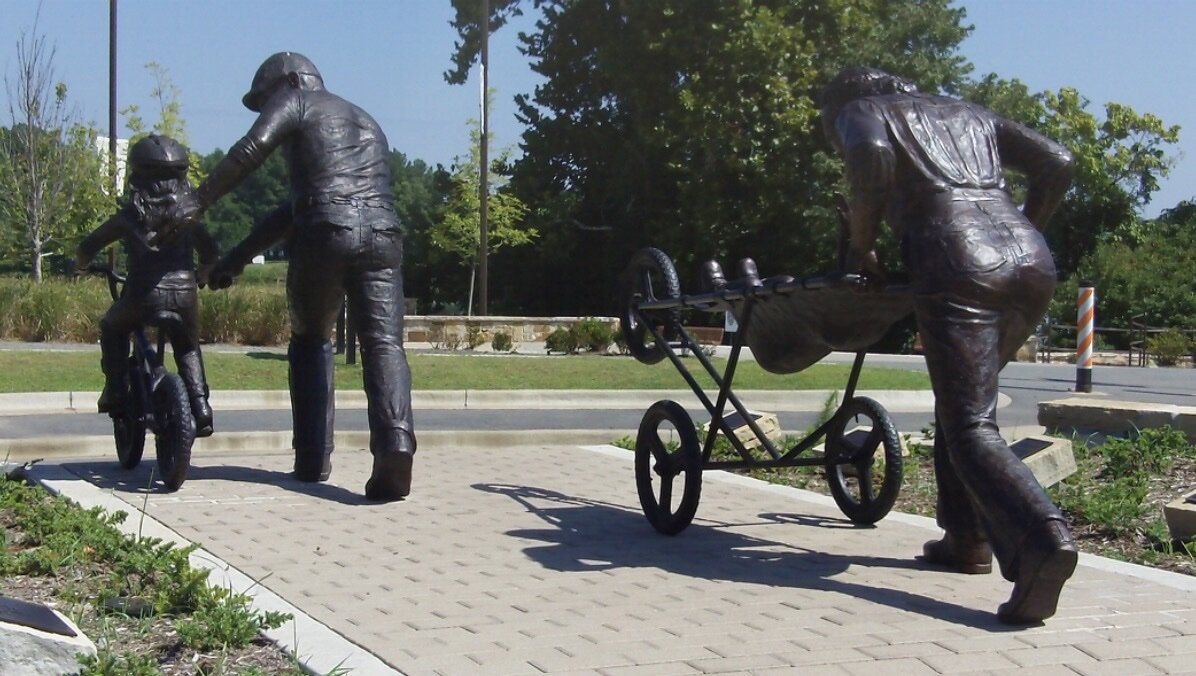
AAS: You did a wonderful sculpture fountain, a gathering place really, called Mother Earth at the North Little Rock Argenta Art Park and a terrific mural Dogtown nearby. Would you talk about those works and the importance of public spaces for art?
Mother Earth, 28’w x 11’h x 9’d, cement and tile mosaics, Argenta Art Park, North Little Rock, Arkansas
KK: Thanks, the Mother Earth fountain is one of my favorite pieces. I fell into doing public work through happenstance, but it’s something I really love. I had noticed after a few years of gallery shows, I was seeing the same faces for the most part. As much as I truly appreciated those people, when I did my first public piece, I realized I was reaching a totally new audience. For instance, at the Mother Earth fountain, I’ve seen two weddings take place, a “Blessing of the Animals” event, and a woman told me once, that she and her daughter would go there every week to pray. Those unexpected payoffs are extremely gratifying.
At this time last year, I had never painted a mural. My first mural was a volunteer piece at the 7th Street underpass in Little Rock. I was one of many artists who came in to do work there after the George Floyd murder. The experiences I had painting that mural, were some of the most gratifying experiences I’ve had as an artist.
Immediately afterward, I did two murals in the Argenta Arts District. These murals (as well as the Mother Earth fountain) were because of the vision of John Gaudin. His work in transforming downtown NLR, cannot be overestimated. John also trusts the artists to do what they do best. When a client does that, the artist always produces a more interesting piece. The client also gets a better value, because the artist is fully invested in what they’re creating and will go above and beyond to satisfy their artistic self. I also have to mention here, that my ole friend Robin Tucker, helped me with the learning curve on murals. He’s had years of experience and was great about sharing his knowledge.

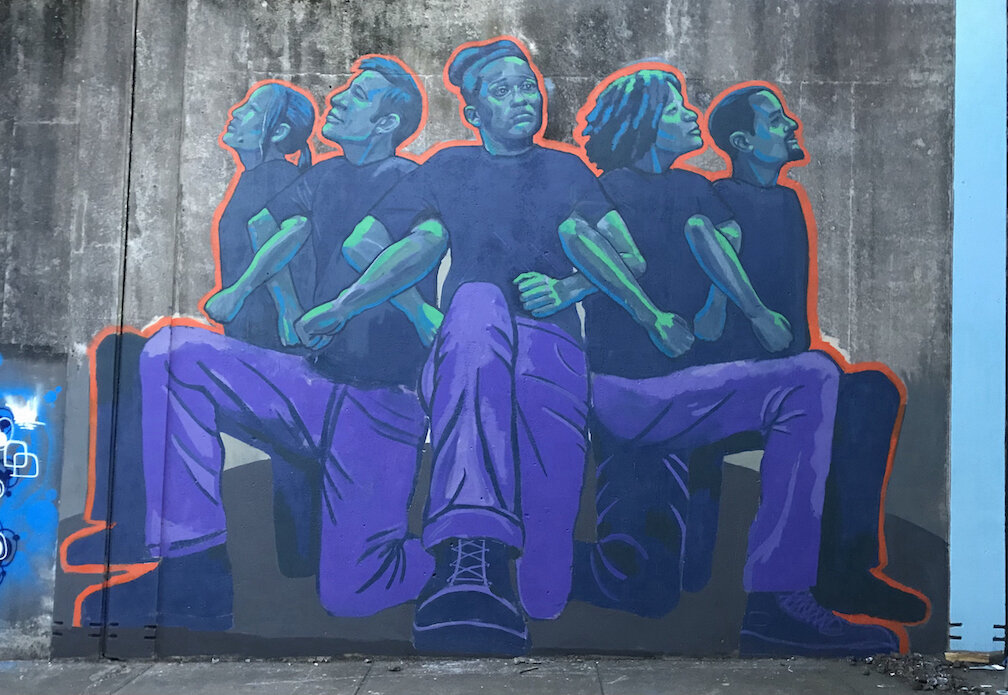

AAS: I do love your sculptures and murals, but it is your paintings and drawings that really come to mind when I think of Kevin Kresse. Your self-portraits and portraits of your family are so filled with emotion – they tell a story, really.
Season’s Cycle, 20” x 24”, oil on canvas
KK: Thanks so much, I’ve always referred to my paintings as “visual diaries.” That’s especially true of the paintings I did when we were living in Italy 10 years ago. I had a lot of time, to reflect on the passage of time, in a place where the remnants of time, are so evident. I like the symbolism in the painting of me shaving, with my son Julian giving me a kiss on the cheek. In the background on his side, the younger tree is present. On my side in the distance, the trees are on top of the tower, looking down on the life below. The painting is about how we all receive a turn with our lives, but we’re all just cycling through like the leaves on a tree.
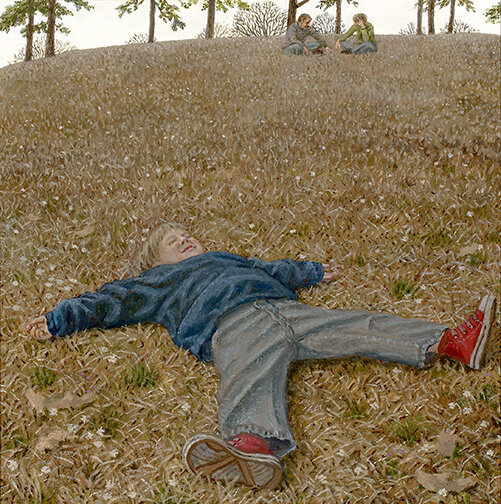
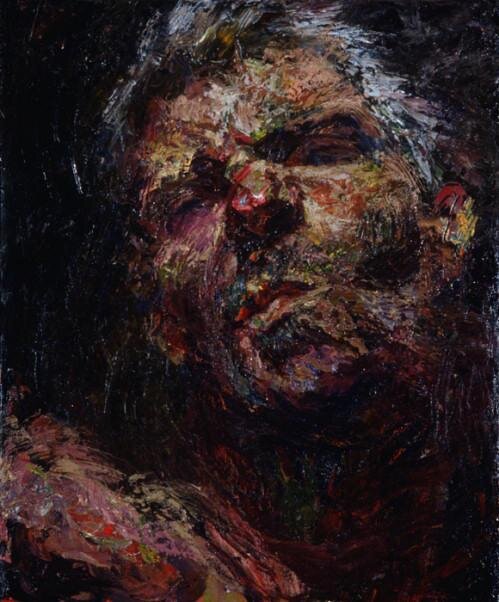
Phil, 20” x 20”, charcoal on paper
AAS: Two of your portraits I really love are Phil and Bill. They truly engage the viewer. You’ve said that portraits and figurative sculptures give permission to the viewer to stare into the eyes of the subject, which is uncomfortable in ‘real life’. Would you talk more about that?
Bill, 24” x 24”, oil on panel
KK: I really started the “eye contact” thing in the beginning of my painting career. As I was learning to paint the figure, I was painting quite a few nudes. I didn’t like the idea of the models in my works just being ogled by the viewers. I was trying to empower them in the paintings. Having them make eye contact with the viewer solved that problem and made for a more psychologically interesting piece. It’s something that I think gives you a deeper experience in a 2-D piece.
In the portraits of Phil and Bill, I think it gives you some better insight into their personalities. Those two portraits were going to be part of a vision I had for an art exhibit. I was thinking about how people have reacted to different mediums that I’ve worked in. I thought it would be interesting to see the same artist, do portraits of the same model, in three different mediums. I was going to do a sculptural bust, a charcoal drawing, and an oil painting of each person. The exhibit would be of about a dozen subjects, or 36 pieces total. I still think it would make an interesting show, but it’s going to have to be down the road… or in my next lifetime!
“The biggest success I’ve had, has been the blending of my artistic life with my family life.”
AAS: You have earned so many important awards and honors such as the Governor’s Art Award for Individual Artist of the Year in 2015. You were also selected by the Mid-America Arts Alliance as one of only four artists to represent the Alliance at the 50th Anniversary of the National Endowment of the Arts. To what do you think you owe your success?
KK: Awards and honors are obviously nice, mainly because anonymity is the death of an art career. Those things raise your profile, help you be seen as “collectible” or whatever. It honestly has nothing to do with my relationship with making art. That is always new and unknown, scary and exciting, inviting and intimidating, with every beginning of a new piece. The biggest success I’ve had, has been the blending of my artistic life with my family life. Our 3 kids have grown up seeing Bridget and me make our decisions, based on what we believe will make us all happy. This is a good point to add this story… Bridget became pregnant about nine or 10 years into my art career. At that point, I was finally getting a “name” and was selling fairly well at the gallery. Then, we found out it was twins… I didn’t think my art sales were stable enough to support a family. I was considering what kind of “real job” I could get for my new role as a responsible father. Bridget told me, “That’s not who you are, we can pull this off.” We’ve been pulling it off for over 20 years now, and I wouldn’t trade a minute of it.
AAS: I usually ask, ‘What’s next?’, but are you even able to think right now beyond completing the Cash statue?
KK: The Cash sculpture is obviously monumental, (no pun intended) but I’m also far into a commissioned bust of Natalie Wood, to go in the Catalina Island Museum, off of Los Angeles, California. I’m also doing a sculpture for Blue Cross’ new building in Springdale, Arkansas.
The good thing about the Johnny Cash piece, is that I’ve already done most of the heavy lifting on it. The head and expression of Johnny is the crux of that piece, and after many months of work on it, I’m a happy camper. I am hoping the high profile status of the Cash piece will make it easier to get the Arkansas musicians series off the ground. I really do have a passion for seeing these incredible artists be honored in bronze.



